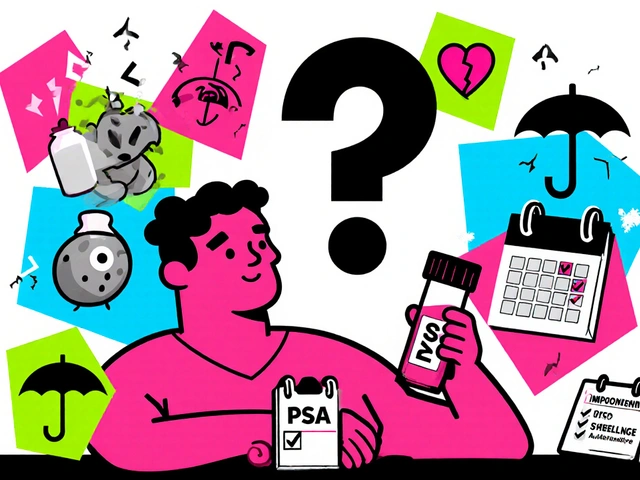Antiviral Medication Comparison Tool
Find Your Best Treatment Match
Answer a few questions to determine which antiviral medication is most appropriate for your situation.
When it comes to treating herpes infections, viral cold sores, or shingles, Valtrex is often the name that pops up first. But it’s not the only game‑changer on the market. This guide breaks down Valtrex (valacyclovir) side‑by‑side with its most common rivals-acyclovir, famciclovir, docosanol, and penciclovir-so you can pick the right antiviral for your situation.
Key Takeaways
- Valtrex offers the most convenient once‑daily dosing for shingles but is pricier than acyclovir.
- Acyclovir remains the budget‑friendly workhorse, especially for cold sores.
- Famciclovir matches Valtrex on speed of symptom relief but has a slightly higher side‑effect profile.
- Topical agents like docosanol and penciclovir work best for early‑stage lesions and have minimal systemic risk.
- Choosing the right drug depends on infection type, severity, cost tolerance, and kidney function.
What Is Valtrex (Valacyclovir)?
Valacyclovir is a prodrug of acyclovir. After you swallow it, your body converts it into acyclovir, which then blocks the DNA polymerase that herpes viruses need to replicate. Because the conversion is efficient, you get higher blood levels with fewer pills. Valtrex is FDA‑approved for genital herpes, oral herpes, and herpes zoster (shingles).
Typical dosing: 1 g twice daily for genital herpes outbreaks, 500 mg twice daily for shingles, and 2 g once daily for suppressive therapy. The drug is excreted by the kidneys, so dosage adjustments are required for impaired renal function.
Top Alternatives on the Market
Below are the five antivirals you’ll most often hear compared with Valtrex.
Acyclovir is the original backbone of herpes treatment. It’s available as a tablet, suspension, and the brand name Zovirax cream. Its oral bioavailability is lower than valacyclovir, meaning you often need to take it five times a day for an outbreak.
Famciclovir is the oral prodrug of penciclovir. It reaches higher intracellular concentrations than acyclovir and is approved for genital herpes, shingles, and shingles prophylaxis after organ transplant.
Docosanol is a topical cream (brand name Abreva) that works by preventing the virus from fusing with skin cells. It’s over‑the‑counter, so you can start it at the first sign of a cold sore.
Penciclovir is sold as the prescription cream Zovirax. Like docosanol, it targets the virus locally and is most effective when applied within 24 hours of lesion appearance.
How the Drugs Stack Up: Comparison Table
| Drug | Form | Typical Adult Dose (outbreak) | Time to Symptom Relief | Average Monthly Cost (USD) | Common Side Effects |
|---|---|---|---|---|---|
| Valtrex (valacyclovir) | Oral tablet | 1 g twice daily (genital), 500 mg twice daily (shingles) | 24-48 hrs | $90‑$120 | Headache, nausea, renal irritation |
| Acyclovir | Oral tablet / suspension / topical cream | 400 mg five times daily (outbreak) | 48-72 hrs | $30‑$45 | Kidney stone risk (high dose), fatigue |
| Famciclovir | Oral tablet | 250 mg three times daily (outbreak) | 24-48 hrs | $70‑$100 | Headache, nausea, occasional rash |
| Docosanol | Topical 10% cream (OTC) | Apply 5 × daily until lesion heals | 48-72 hrs (if started early) | $15‑$20 | Mild local irritation |
| Penciclovir | Prescription 1% cream | Apply 5 × daily for 4 days | 24-48 hrs (early use) | $40‑$55 | Burning, itching at application site |
When to Choose Valtrex Over the Others
If you need rapid relief with minimal pill burden, Valtrex shines. Its higher plasma levels mean you can treat shingles with just two pills a day, which improves adherence for older adults. Valtrex also has the most robust data for suppressive therapy-taking 500 mg daily can cut genital herpes outbreaks by up to 80 %.
However, the cost can be a hurdle. For patients with good kidney function who can tolerate multiple doses, acyclovir delivers comparable outcomes at a fraction of the price. Famciclovir is a solid middle ground: slightly cheaper than Valtrex but still requires three daily doses.
Topical vs Systemic: How the Choice Impacts Recovery
Topical agents (docosanol, penciclovir) act locally, so they pose virtually no risk to the kidneys or liver. They’re perfect for isolated cold sores that you catch early. The downside is they don’t prevent viral shedding elsewhere, so they’re not suitable for genital herpes or shingles.
Systemic drugs-Valtrex, acyclovir, famciclovir-travel through the bloodstream, reaching dormant viral reservoirs. That’s why they’re the go‑to for shingles, where the virus lurks in nerve ganglia. If you have a compromised immune system, systemic therapy is often non‑negotiable.
Side‑Effect Profile: What to Watch For
All antivirals share a core set of mild side effects: headache, nausea, and fatigue. The big red flag is kidney stress, especially with high‑dose acyclovir or prolonged Valtrex use. Patients with chronic kidney disease should have doses reduced based on creatinine clearance. Famciclovir can cause a rash in a small percentage of users; if you develop a widespread rash, stop the medication and contact a doctor.
Topicals are generally safe, but some users report burning or itching where the cream is applied. If irritation persists beyond a couple of days, you might be allergic and should switch products.
Cost Considerations and Insurance Coverage
In the United States, most insurance plans cover acyclovir and famciclovir as generic drugs, making them budget‑friendly. Valtrex, being a brand‑name product, often requires a higher co‑pay unless you qualify for a manufacturer coupon. Outside the US, especially in Australia where you live, Valtrex is listed on the PBS (Pharmaceutical Benefits Scheme) for certain indications, which can lower out‑of‑pocket costs markedly.
For over‑the‑counter options like docosanol, the price is fixed and affordable, but you won’t get insurance reimbursement.
Practical Decision Tree
- If you have shingles or frequent genital outbreaks → consider systemic therapy.
- Do you need the fewest pills possible? → Valtrex.
- Is cost the primary concern? → Acyclovir (generic) or Famciclovir if you can manage three daily doses.
- Is the infection limited to a single cold sore caught early? → Topical docosanol or penciclovir.
- Do you have kidney disease? → Reduce dose of Valtrex or switch to low‑dose acyclovir with monitoring.
Frequently Asked Questions
Can I switch from Valtrex to acyclovir mid‑treatment?
Yes, but you should finish the current Valtrex course before starting acyclovir to avoid resistance. Talk to your doctor about the correct timing and dosage.
Is Valtrex safe during pregnancy?
Valtrex is classified as Category B in the US, meaning animal studies show no risk but human data are limited. Most physicians prescribe it only if the benefits outweigh potential risks.
How quickly does Valtrex stop viral shedding?
In genital herpes, a 500 mg dose taken within 24 hours of symptom onset can reduce viral shedding by about 50 % within 48 hours.
Do I need to stay hydrated while on Valtrex?
Staying well‑hydrated helps the kidneys clear the drug, especially if you have borderline kidney function. Aim for at least 2 L of water daily.
Are there any drug interactions with Valtrex?
Valtrex can increase the nephrotoxic potential of drugs like furosemide and ibuprofen. Always list all medications with your prescriber.
Bottom Line
Choosing the right antiviral boils down to three questions: What infection am I treating? How much can I afford? Do I have any kidney or drug‑interaction concerns? Valtrex gives you speed and convenience but at a higher price. Acyclovir is cheap and reliable for mild outbreaks. Famciclovir offers a middle‑ground efficacy with moderate dosing. For early, localized cold sores, topicals like docosanol or penciclovir are safe, fast, and wallet‑friendly.
Speak with your healthcare provider, weigh the pros and cons outlined above, and you’ll land on the option that fits your lifestyle and health needs.



October 24, 2025 AT 12:49 PM
Great overview the pros and cons of each antiviral are clear and easy to follow
November 1, 2025 AT 00:32 AM
One cannot help but notice the pretentious tone in some sections the author tries to sound scholarly while actually obscuring simple facts 😒 the comparison table is useful yet the language feels needlessly lofty the cost discussion could have been more grounded the mention of kidney function is relevant but buried among marketing fluff
November 8, 2025 AT 13:14 PM
Valtrex does have better bioavailablity than acyclovir but you should check dosage if you have kidney issues
November 16, 2025 AT 01:56 AM
The ethical implications of prescribing high‑cost antivirals without addressing socioeconomic disparities are indefensible; clinicians must prioritize evidence‑based regimens that minimize financial toxicity while maintaining therapeutic efficacy, otherwise we perpetuate a healthcare model that privileges profit over patient welfare.
November 23, 2025 AT 14:39 PM
🔥💊 When it comes to fighting herpes you need a weapon that hits hard and fast-Valtrex is that bullet!!! 💥💯 No more five‑times‑a‑day juggling pills-just two tablets and you’re good to go! 🇺🇸💪
December 1, 2025 AT 03:21 AM
For patients with impaired renal function it is essential to adjust the dosing interval of valacyclovir according to creatinine clearance; a common practice is to reduce the dose to 500 mg once daily for a clearance below 30 mL/min. This adjustment helps mitigate the risk of nephrotoxicity while preserving antiviral efficacy.
December 8, 2025 AT 16:03 PM
It is commendable that this guide delineates both systemic and topical options, thereby empowering clinicians to tailor therapy to individual patient profiles. 😊 Your inclusion of cost considerations further enhances its practicality.
December 16, 2025 AT 04:46 AM
The pharmacokinetics of famciclovir involve rapid convrsion to penciclovir which then achieves higher intracellular concentrations than acyclovir – a key factor for faster symptom relief. However, watch out for the occasional rash as a side effect.
December 23, 2025 AT 17:28 PM
When deciding between a systemic antiviral and a topical cream, consider the stage of the lesion. Early‑stage cold sores that are still erythematous respond well to docosanol or penciclovir applied five times daily within the first 24 hours. Systemic agents like valacyclovir or famciclovir are preferable for genital herpes or shingles where the virus resides in nerve ganglia and topical therapy would not reach the site of infection. Additionally, patients with chronic kidney disease should discuss dose reduction with their provider to avoid nephrotoxic accumulation.